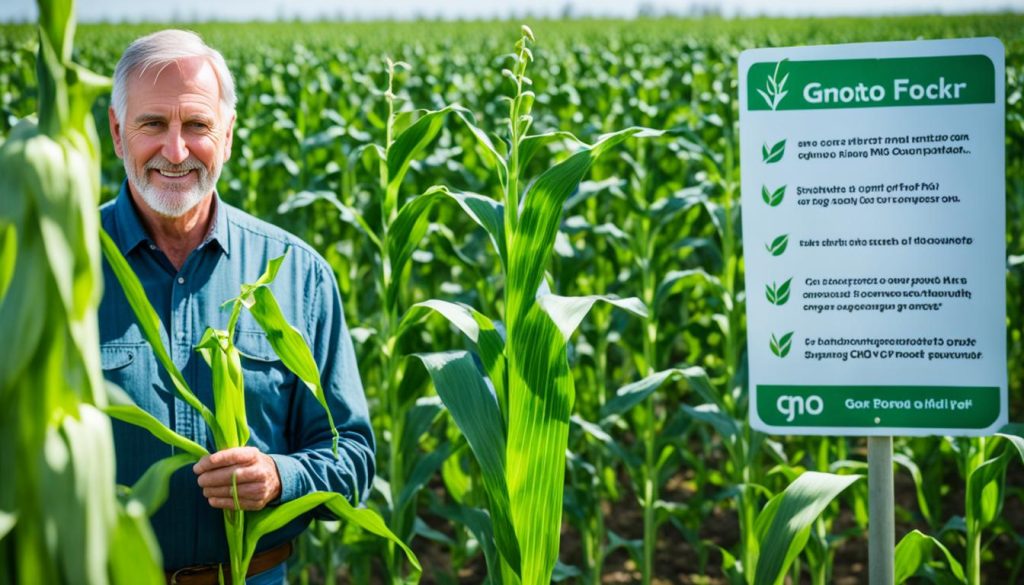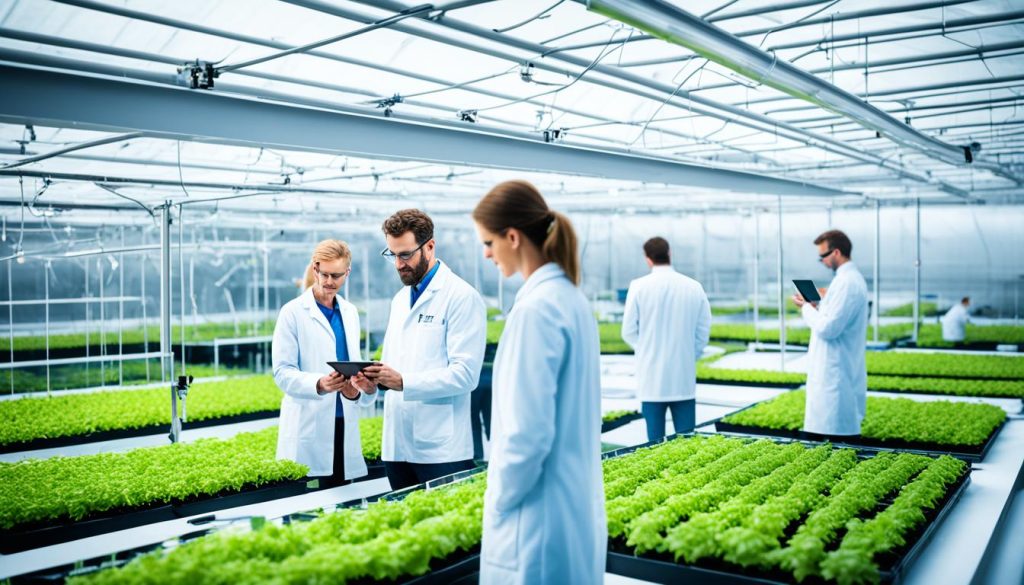Genetically modified organisms (GMOs), also known as genetically engineered or transgenic foods, have sparked a lot of debate. Many experts say GMO foods are safe and good for the planet. Yet, some folks worry about their health and environmental effects1. The U.S. Department of Agriculture (USDA) reports that GMO seeds are used in over 90% of maize (corn), cotton, and soy in the U.S1. This means many foods you eat might have GMOs.
Thinking about your food choices is key to your health and the planet’s future. It’s important to know what GMOs are and their good and bad sides. This article aims to give you a balanced view. It will help you decide if GMO foods are right for you and your family.
Key Takeaways
- Over 90% of maize (corn), cotton, and soy grown in the U.S. are from genetically modified seeds1.
- GMO technology has reduced global chemical pesticide use by 8.3%1.
- There is evidence suggesting that glyphosate exposure may increase the relative risk of non-Hodgkins lymphoma by 41%1.
- Foods with more than 0.9% GMO ingredients must be labeled as “genetically modified” or “produced from genetically modified [name of food]” in the European Union1.
- As of 2022, foods with GMO ingredients in the U.S. must be labeled as “bioengineered food” or have a scannable code for information1.
What are Genetically Modified Foods (GMOs)?
Definition and Prevalence of GMO Crops
GMOs change the genes of plants, animals, or microorganisms in ways not found in nature2. These foods are made to offer benefits to farmers and consumers, like lower costs, longer shelf life, or more nutrients2. They help crops fight off diseases and tolerate herbicides better2.
In the U.S., GMO crops are very common, with over 90% of soy, cotton, and corn grown using genetic methods2. Cotton, corn, and soybeans are the top GMO crops here3. These crops are used to make many foods and drinks, like corn syrup, oils, and animal feed3.
Other GMO crops include apples, alfalfa, and many others3. The first GMO product, human insulin, was introduced in 19824. Most GMOs in the U.S. are for animal feed4.
Genetic modification helps crops resist diseases and herbicides, leading to more food and more reliable crops4. For example, GMO rice has helped prevent blindness in kids in poor countries4.
It can take many years to breed plants naturally for certain traits. Genetic modification speeds up this by using science to add the traits quickly2.
Potential Advantages of GMO Foods
Genetically modified (GMO) foods have many benefits for farmers and consumers. They help control pests, use fewer pesticides, grow more food, and taste better.
GMO crops fight pests naturally. For example, GMO corn and soybeans have a gene that makes a toxin against pests5. This means less need for harmful chemicals, which is good for the planet. In fact, GMOs have cut down on chemical pesticides by 8.3% worldwide5.
These crops also do well in tough conditions like droughts and fight off diseases. This leads to more food for farmers5. In India, farmers growing GMO cotton saw their yields go up by 31%, used 39% less insecticide, and made more money5.
Genetic engineering can also make food healthier and tastier5. For example, “golden rice” can prevent Vitamin A deficiency, which is a big problem in some parts of the world6.
| Advantage | Benefit |
|---|---|
| Improved Pest Control | Reduced pesticide use and better environmental impact |
| Increased Crop Yield | Higher profits for farmers and more food for consumers |
| Enhanced Nutritional Value | Improved health outcomes, especially in developing countries |
| Better Flavor and Appearance | More appealing and desirable food products |
GMO foods offer many benefits, from fighting pests to being healthier. This makes investing in GMO technology a good choice for farmers and consumers576.
Is It Worth Investing in Genetically Modified Foods?
The debate on GMO foods is ongoing. They offer benefits like more crops and less pesticide use. But, there are concerns about their health and environmental effects8.
One big worry is allergies. GMO crops could cause allergic reactions in some people8. There’s also concern about the use of herbicides like Roundup on these crops. This could harm bees and other beneficial insects8.
Many think GMO foods are safe, based on what the FDA, EPA, and USDA say8. Yet, we need more research to fully grasp their risks and benefits8.
Many Americans are unsure about GMO foods8. Some have heard a lot, some a little, and some nothing at all8. This makes it hard for people to decide if GMO foods are a good choice.
| Potential Advantages of GMO Foods | Potential Risks of GMO Foods |
|---|---|
Deciding on GMO foods is complex. It involves weighing their benefits and risks. With more research, people can make better choices about GMOs in their diets8.
Identifying and Avoiding GMO Foods
More and more GMOs are in our food, making people look for ways to avoid them. Some don’t want GMOs for health or personal reasons. Luckily, there are ways to spot GMOs and choose non-GMO foods.
Labeling Requirements and Non-GMO Options
Since January 2022, the USDA requires labeling for foods with GMOs. They call it “bioengineered food,” not “GMO”11. This can be tricky, but other labels can help you spot GMOs.
Look for the “Non-GMO Project Verified” label to ensure no GMOs12. Also, “100% organic” products can’t have GMOs, thanks to organic rules11.
To dodge GMOs, read labels well and watch for these labels. Eating fresh, whole foods like fruits, veggies, and meats is also a good move. These are less likely to have GMOs, found mostly in processed foods.
| Label | Meaning |
|---|---|
| Bioengineered Food | Indicates the product contains GMO ingredients, as required by the USDA as of January 2022. |
| Non-GMO Project Verified | The product has been independently verified to contain no genetically modified ingredients. |
| 100% Organic | The product cannot contain any GMO ingredients, as organic certification prohibits the use of genetically engineered crops or additives. |
Knowing about these labels and choosing non-GMO can help you make smart food choices12. It lets you avoid GMO risks and support a greener food system.
“Mandatory GMO labeling would add less than a penny a day to consumers’ grocery bills, which is a small price to pay for the right to know what’s in our food.”
The Future of GMO Technology
As the future of GMO technology unfolds, researchers are finding new ways to make crops better and more sustainable. About 40% of US farmland, or 170 million acres, is now used for genetically modified (GM) crops13. In 2015, 14 GM crops were grown in the US, leading to a 6% increase in chemical use13.
New advancements in genetic engineering are speeding up, changing how we develop crops. Companies are making crops that resist pests and weeds at the same time13. By 2017, there were GM crops that were easier for animals to digest and some that could fight diseases better13.
GM crops could bring big benefits, but we still don’t know much about their long-term effects on health and the environment. Debates over regulation and labeling GM products and how people see them will guide their future13. It’s important to keep testing GM crops safely and be open about their benefits and risks.
“Few genetically engineered traits have been commercialized, and those that have been incorporated into major commodity crops grown on millions of hectares worldwide.”14
Understanding complex traits like drought resistance is still a challenge14. But genome editing could help make crops better by changing specific genes. Using both traditional breeding and genetic engineering together could lead to more progress14.
The future of GMO technology looks promising. The industry is set for big changes, despite the complex rules and public opinions. This technology could help solve big problems like hunger and environmental issues. By looking at both the good and bad sides, and being open, GM crops could change how we grow and eat food.
Conclusion
The debate on genetically modified (GM) foods is ongoing. Supporters see benefits like better pest resistance and more food. But, there are worries about their effects on health and the planet8.
In the US, most soybeans, corn, cotton, and canola are GM8. Yet, only 11% of Americans think most of their food has GM parts. And 40% believe some of their food does8. This shows how important it is to make informed choices about GM foods.
When thinking about GM foods, keep up with new research and info. Look for trustworthy sources and think about the pros and cons. Your choices can help shape the future of GM technology15.
FAQ
What are genetically modified foods (GMOs)?
How prevalent are GMO crops in the United States?
What are the potential advantages of GMO foods?
What are the potential concerns around GMO foods?
How can I identify and avoid GMO foods?
What is the future of GMO technology in agriculture?
Source Links
- GMO Pros and Cons, Backed by Evidence
- Food, genetically modified
- Genetically modified organisms – GMOs: MedlinePlus Medical Encyclopedia
- What Are Genetically Modified Foods?
- Biotechnology – A Solution to Hunger? | United Nations
- Benefits outweigh risks from genetically modified plants
- Global economic benefits of GM crops reach $150 billion
- 3. Public opinion about genetically modified foods and trust in scientists connected with these foods
- Genetically modified crops: hope for developing countries?: The current GM debate widely ignores the specific problems of farmers and consumers in the developing world
- Learning to Love G.M.O.s (Published 2021)
- Are GMO Foods Safe for My Child? AAP Policy Explained
- GMO Foods: What You Need to Know – Consumer Reports
- The Future of GMO Crops | Science of GMOs
- Future Genetically Engineered Crops – Genetically Engineered Crops
- Genetically Modified Products, Perspectives and Challenges



